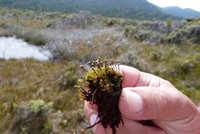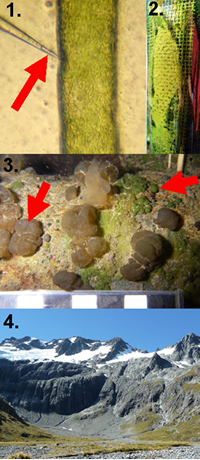Issue 4, May 2013
Latest research news
eFlora treatment: A Moss Flora treatment of the family Amblystegiaceae by Dr Allan Fife has just been reviewed and is now being prepared for electronic publication in the eFlora. Other family treatments of mosses will also be completed for this purpose over the next year. You can find the eFlora at www.nzflora.info.
Major new version of the key to native orchids of NZ: The new version, containing more images, full captions, character explanations, and other improvements, has been uploaded at www.landcareresearch.co.nz/resources/identification/plants/native-orchid-key. This interactive tool will allow you to more easily identify native orchids. It is authored by Murray Dawson, Jeremy Rolfe and the NZ Native Orchid Group and is funded by TFBIS (the Terrestrial & Freshwater Biodiversity Information System Programme).
Tayloria tasmanica: a moss new to New Zealand, and a detective story
 In early February 2013, Landcare Research plant ecologist Colin Meurk collected an unusual and unrecognised moss from Freshwater Flats, Stewart Island. This distinctive plant was quickly determined by Allan Herbarium bryologist Allan Fife as Tayloria tasmanica, a rare species previously thought to be endemic to Tasmania. The Stewart Island collection was made by Colin from a boggy trackside with another moss, Campylopus acuminatus var. kirkii, at low elevation and about 500 m from the Freshwater River swing bridge.
In early February 2013, Landcare Research plant ecologist Colin Meurk collected an unusual and unrecognised moss from Freshwater Flats, Stewart Island. This distinctive plant was quickly determined by Allan Herbarium bryologist Allan Fife as Tayloria tasmanica, a rare species previously thought to be endemic to Tasmania. The Stewart Island collection was made by Colin from a boggy trackside with another moss, Campylopus acuminatus var. kirkii, at low elevation and about 500 m from the Freshwater River swing bridge.
Tayloria tasmanica belongs to a family of mosses unusual for growing primarily on dung and rotten flesh, and for producing odoriferous aromatic compounds in the spore-producing capsules which are dispersed by insects. Because this was a surprising species record for New Zealand, and because Colin had taken a beautiful photograph of it in the field (above), Allan sent a short note announcing the discovery to several relevant botantists around the world1. In addition to the range extension of the species to New Zealand, the attention of several workers immediately focused on a recent report2 of T. tasmanica occurring on the subantarctic Macquarie Island. This report was based on an interpretation of an 1893 collection by Leonard Rodway, a 19th to early 20th century Tasmanian “government botanist”. A flurry of emails flew around the globe and within a few hours the combined expertise of several workers in New Zealand, Tasmania, and the United States led to the indubitable conclusion that the provenance of the Rodway collection (now in the Te Papa herbarium in Wellington) had been incorrectly interpreted. The Rodway collection was made at Macquarie Harbour in western Tasmania, not from Macquarie Island. The rapid clarification of the range of T. tasmanica involved collections, databases, and experts at botanical institutions in 3 countries, and the range of this beautiful (if odoriferous) Tasmanian species had been clarified and dramatically extended to include New Zealand.
~Allan Fife and Colin Meurk, Research Scientists
1Special thanks to Patrick Brownsey, Lyn Cave, Bernard Goffinet, and Rod Seppelt.
2Goffinet, B. 2006: Splachnaceae, Fl. Australia 51: 173–181
Student projects on algae, associated with the Allan Herbarium
 Scientists at the Allan Herbarium are actively involved in student supervision. Four PhD students are currently working on projects with Phil Novis, the Herbarium’s phycologist.
Scientists at the Allan Herbarium are actively involved in student supervision. Four PhD students are currently working on projects with Phil Novis, the Herbarium’s phycologist.
Abishek Muralidhar (University of Canterbury) researches turgor regulation, the process by which organisms maintain a constant internal hydrostatic pressure despite changes in external salt concentration. Different species of the yellow-green alga Vaucheria colonise terrestrial, freshwater, estuarine, and marine habitats, making them ideal subjects, especially since the related and morphologically similar Oomycota – non-photosynthetic organisms including potato blight – have been shown to lack turgor regulation. Abishek measures turgor and ion movements directly using a single cell pressure probe (image 1, with arrow) and voltage clamping. Genetic characterisation of his different strains of Vaucheria is being carried out at Landcare Research.
Audrey Commault (Lincoln University and Lincoln Ventures) uses photosynthetic microbial fuel cells (pMFCs) to generate electricity with the assistance of algae. A pMFC consists of a negative electrode in anaerobic conditions – in this case, buried in sediment – connected to a positive electrode (image 2, with a green algal biofilm) in the presence of oxygen. Bacteria in the sediment break down the surrounding organic matter, and transfer electrons to the electrode. These travel through a circuit to the positive electrode, where they reduce oxygen in water, producing milliamps of current. Algae contribute oxygen for this reduction with their photosynthesis. Other strategies for its supply are less cost efficient, since algae need no energy input apart from sunlight and can produce oxygen in close proximity to the electrode.
Faradina Merican (University of Canterbury) has described more than 50 morphospecies of cyanobacteria found in Kaituna River and its tributary streams on Banks Peninsula. Several of these are new records for New Zealand. Faradina recorded distinct patterns in spatial and temporal distributions of macroscopic growths (arrows in image 3, scale in cm) over a year in the field. Substratum type, light intensity and stream order all have strong effects on distribution. Additionally, Faradina’s molecular investigations have shown diverse evolutionary origins of similar morphospecies and complex dispersal patterns in Banks Peninsula cyanobacteria.
Kishore Gopalakrishnan (University of Canterbury) has collected 33 samples containing algae from the alpine zone in Canyon Creek, South Canterbury (image 4), and has established 15 pure strains of these in culture. He has sequenced genes from all these strains, carried out microscopic and phylogenetic analyses, and is currently preparing taxonomic manuscripts describing the material. A number of these strains represent new species or new records for New Zealand.
Recent publications involving Allan Herbarium researchers
Dennis PG, Sparrow AD, Gregorich EG, Novis PM, Elberling B, Greenfield LG, Hopkins DW 2013. Microbial responses to carbon and nitrogen supplementation in an Antarctic dry valley soil. Antarctic Science 25: 55–61.
Heenan PB, McGlone MS 2013. Evolution of New Zealand alpine and open-habitat plant species during the late-Cenozoic. New Zealand Journal of Ecology 37: 105–113.
Richardson SJ, Allen RB, Buxton RP, Easdale TA, Hurst JM, Morse CW, Smissen RD, Peltzer DA 2013. Intraspecific relationships among wood density, leaf structural traits and environment in four co-occurring species of Nothofagus in New Zealand. PLoS ONE 8(3): [early view online].
